What is Linear TV? A Complete Guide for Advertisers
Linear TV still plays a major role in modern media strategies. Learn what it is, how it works, and how to integrate it with digital channels to maximize campaign success.
Writer: Weston Wheeler
Date: July 15, 2025

Over the past decade, streaming services have changed how audiences engage with television. But according to data from Simpli.fi’s TV Ad Insights Dashboard, while streaming TV continues its dominance, linear TV still accounts for nearly one-third of total TV consumption on ad-supported streaming TVs, especially for live events, news, and sports.
In other words, linear television isn’t obsolete; it’s adapting. For advertisers, it remains a powerful part of a holistic media strategy, especially for advertisers looking to reach large, engaged audiences across diverse demographics.
So, what is linear TV, and how does it differ from streaming and Connected TV (CTV)? Let’s take a closer look.
DEFINING LINEAR TV
Linear TV is the traditional format of television broadcasting, where content is delivered in real time on a fixed schedule. Before the rise of on-demand streaming and connected devices, linear television was the standard way people watched shows, sports, and news.
When it comes to linear TV, meaning television content that airs according to a preset timeline and requires viewers to tune in live, the format is defined by its consistency and broad reach. The linear TV definition refers to a model where programming is centrally scheduled and broadcast to all viewers at the same time, without options for skipping, pausing, or selecting content on demand.
What Makes It “Linear”?
The term “linear” refers to the order in which content is broadcast. Programming is delivered to all viewers at the same time, based on a schedule created by local or national broadcasters. Unlike streaming, there’s no fast-forwarding, rewinding, or skipping ahead.
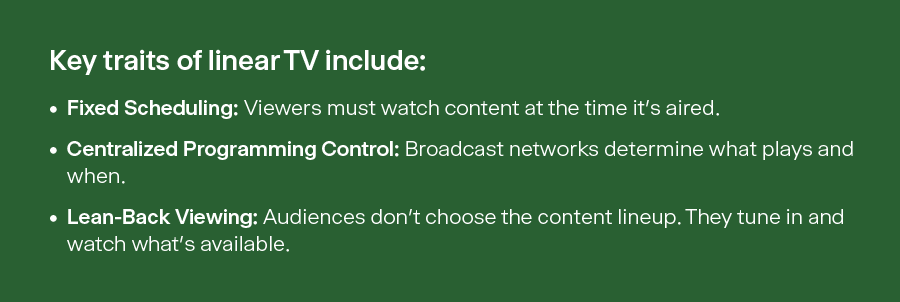
What is linear content?
Linear content is media presented to audiences at a specific, predetermined time in a fixed, sequential order—following a fixed schedule. Unlike on-demand content, where viewers choose what to watch and when, linear content requires audiences to tune in at a particular moment to see it as it’s broadcast.
Linear TV is still relevant today, particularly when it comes to delivering consistent reach and premium placements during major events or time slots.
WHAT IS LINEAR TV ADVERTISING?

Linear TV advertising refers to placing commercials during scheduled programming, such as cable or broadcast television. These ads run in real time and are generally targeted to broad audience segments like age, gender, or geographic region.
Unlike digital media, linear TV ads are typically purchased months in advance through upfront or scatter markets. This long lead time can make it difficult for advertisers to react to real-time trends or optimize based on performance. It also limits flexibility, especially for brands looking to align campaigns with fast-moving promotions or evolving customer behaviors.
While it doesn’t support one-to-one targeting, linear advertising remains effective for building mass awareness, particularly during high-reach programming like live sports or primetime TV.
How Linear TV Advertising Works
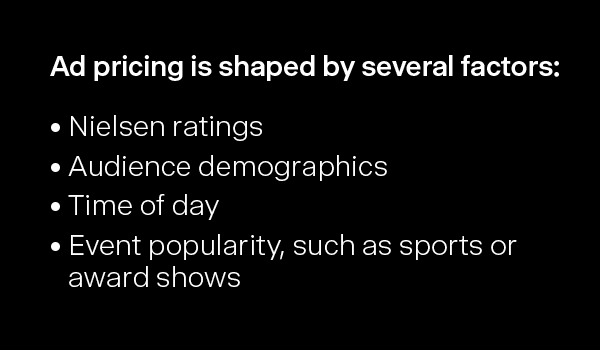
Linear TV ad inventory is sold ahead of time and priced based on projected audience size. Advertisers often use dayparting, a strategy that segments the broadcast day into time blocks — early morning, daytime, primetime — to better align messaging with viewing habits.
This buying model differs from programmatic digital, where decisions are made in real time using behavioral data. Instead, linear requires careful upfront planning based on historical viewership.
Advantages of Linear TV Advertising
Given that linear TV viewership is generally declining, many advertisers question its relevance as an ad space. So, what is linear TV’s contribution to the modern-day marketing mix? Here’s a list of the unique advantages you may uncover when you integrate linear TV advertising into a broader cross-channel media strategy:
- High Audience Reach: Millions continue to watch linear broadcast TV, especially for live events and prime content.
- Premium Placements: You can secure high-profile slots during primetime shows or major live events, ensuring optimum visibility in a trusted, high-quality environment.
- Captive Engagement: Linear TV ads benefit from full-screen visibility and a captive audience, as viewers are unable to skip ads during commercial breaks when viewing live.
- Brand Control: Compared to many digital environments, linear TV offers more predictable and controlled ad placements.
- Strategic Amplification: Linear campaigns extend the impact of digital and mobile efforts when part of a cross-channel plan.
Despite the changing tides, linear TV remains a powerful tool in your marketing arsenal. By blending the mass reach of linear with advanced digital targeting, your brand can harness both worlds’ full potential to create wide-reaching, credible, and engaging campaigns.
Challenges of Linear TV Advertising
While it offers several benefits, linear advertising has limitations that are important to weigh against your campaign goals. Here’s what to keep in mind:

- Shifting Audience Demographics: Younger markets increasingly favor streaming services, leading to a smaller share of Millennial and Gen X viewers.
- Higher Costs Compared to Digital: Prime slots can be expensive, which limits accessibility for smaller budgets.
- Limited Targeting Capabilities: Because ads serve broad audience segments rather than individual consumers, linear ads lack the precise targeting that programmatic advertising offers.
- No Cross-Device Matching or Measurement: Linear ads can’t track or retarget viewers across devices, which limits attribution, measurement, and sequential messaging strategies.
- Ad Clutter: Traditional linear broadcasting features long commercial breaks, which increase competition for viewer attention and increase the likelihood of ad fatigue.
Ultimately, you must weigh the benefits of mass exposure against the limitations of targeting and cost to determine the viability/relevance of linear ads in each specific use case.
Who Should Use Linear TV Advertising?
As we’ve seen, linear TV advertising isn’t a one-size-fits-all solution. However, it remains an effective tool for certain campaigns, especially when integrated with digital and streaming channels. The best candidates for linear ad strategies include:
- National & Multi-Market Brands: Large companies seeking broad reach to build awareness and reinforce messaging across multiple channels.
- Regional & Local Businesses: Companies in areas where linear channels still command strong viewership, particularly among older audiences or in smaller markets.
- Political Campaigns & PSAs: Campaigns seeking broad local exposure coupled with credibility to boost trust and visibility.
- Cross-Channel Advertisers: Brands seeking to leverage linear for its mass market reach while utilizing digital channels for more targeted, data-driven campaigns.
The bottom line? Advertisers in these markets can combine the broad reach of linear TV with the precision of digital channels to create well-rounded, impactful campaigns that target diverse audiences across multiple platforms to maximize effectiveness.
UNDERSTANDING THE DIFFERENCES BETWEEN LINEAR TV, STREAMING, AND CTV
To fully grasp the role of linear TV in today’s diverse media landscape, we must compare it with streaming services and connected TV (CTV), both of which are gaining dominance in the market. While all offer television viewing experiences, they differ in how they deliver content and the unique opportunities they provide for advertisers.
Linear TV vs. Streaming

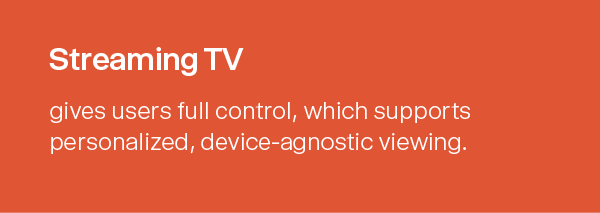
As behavior shifts, many viewers now expect flexible experiences, especially those who regularly “second screen” with phones or tablets while watching
Linear TV vs. Connected TV (CTV)
Connected TV (CTV) refers to internet-enabled TVs, enabling viewers to watch content via apps, websites, and streaming services using devices like smart TVs, set-top boxes, TV sticks, and gaming consoles. Here’s a rundown of the primary differences between linear and CTV:
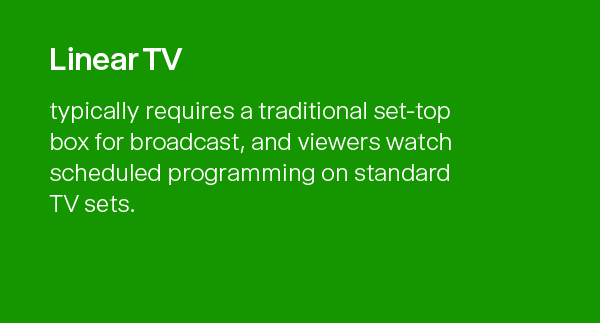
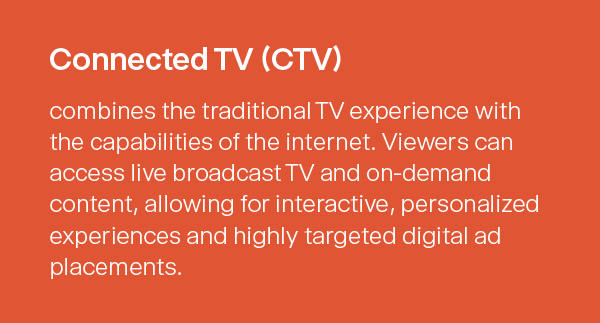
Advertisers often see the best results by combining linear TV for reach with CTV for targeting and attribution. It also guarantees broader reach, as research shows that most US households access CTV content.
IS LINEAR TV STILL RELEVANT TODAY?
In short, yes. Although linear may no longer dominate viewing habits, it still attracts large, engaged audiences, especially during live events or primetime shows.
Does linear represent a viable standalone solution? No, because advertisers focusing solely on linear will likely miss key audience segments (i.e., younger, digitally native groups). That said, there are several valid reasons for incorporating linear aspects into your overall marketing strategy:
- Live Events & Sports Dominance: Linear television remains the primary platform for broadcasting major live events and sports. For example, the 2025 Super Bowl attracted over 127 million viewers, setting a new record for the event. Similarly, NBCU’s coverage of the 2024 Paris Olympics averaged 30.6 million viewers across all platforms, marking an 82% increase from the previous Games.
- High Engagement Level with Traditional Viewers: A significant number of Baby Boomers and Gen Xers still favor scheduled programming like talk shows and prime-time series. For example, popular shows like 60 Minutes, Georgie & Mandy’s First Marriage, and The Voice consistently draw millions of viewers, demonstrating linear TV’s ability to maintain high levels of engagement through traditional viewing experiences.
- Brand Control & Premium Placements: The structured nature of a linear broadcast allows for strategic ad placement during premium content. Linear ads provide a controlled, brand-safe environment for companies seeking to maintain a positive image while reaching a broad, engaged audience.
With these strengths in mind, the real power of linear is unlocked when integrated with multichannel strategies. A more holistic approach, coupled with the added precision of digital targeting, ensures a diverse, engaged audience and higher levels of awareness, impact, and effectiveness.
THE FUTURE OF LINEAR BROADCAST ADVERTISING
Linear TV is no longer operating in a silo. As audience behaviors shift and digital capabilities expand, linear is evolving, not disappearing. Today’s advertisers aren’t asking if linear belongs in their strategy, but how it can work alongside other channels to drive better results.
Two key trends are driving this transformation: improved audience targeting and the rise of integrated, cross-channel campaigns. Together, these developments are redefining how advertisers leverage linear broadcast as part of a more connected, performance-driven approach.
Household-Level Targeting Is Gaining Ground

Historically, linear advertising relied on broad demographic data and fixed time slots. That’s changing. With the rise of data partnerships and addressable TV capabilities, advertisers can now reach households based on more specific traits, such as geography, interests, or lifestyle indicators.
While this doesn’t match the granularity of digital targeting, it marks a meaningful step forward. It allows advertisers to deliver more relevant messages without losing the reach that makes linear so valuable.
Cross-Channel Campaigns Are the New Norm
Modern media plans aren’t built around either/or decisions. Instead, marketers combine linear TV’s mass visibility with the precision and flexibility of CTV, mobile, and programmatic display to create unified, full-funnel strategies.
This integrated approach enables:
- Message consistency across screens and platforms
- Broader audience coverage, from traditional to digital-first viewers
- Holistic performance tracking and attribution
At Simpli.fi, we help advertisers connect the dots across every channel, making campaigns more cohesive and measurable from the start.
What This Means for Advertisers
Linear TV is evolving to support today’s marketing demands. With better data, stronger tools, and seamless integration into cross-platform media plans, it has become more adaptable, more accountable, and more valuable than ever. When thoughtfully aligned with digital channels, linear broadcast advertising doesn’t just hold its ground—it strengthens the overall performance of your campaign.
MAXIMIZE LINEAR TV CAMPAIGNS WITH SIMPLI.FI
Linear TV remains a consideration within the modern advertising ecosystem. It delivers consistent reach, high-impact placements, and strong engagement, especially during live events and primetime programming. However, success depends on more than traditional tactics in a fragmented media landscape. Advertisers need platforms that unify strategy, simplify execution, and drive measurable performance.
Simpli.fi helps advertisers bring linear and digital together.
Our platform offers programmatic linear TV buying, integrated cross-channel planning, and real-time insights — all designed to help you reach the right audience with greater efficiency. Whether you’re looking to amplify your message across markets or align linear with channels like Connected TV (CTV) and mobile, Simpli.fi provides the tools to do it seamlessly.
Learn more about our media buying solutions, explore our streaming and CTV capabilities, or connect with our team to get started.
 | Weston Wheeler
Sr. Content Marketing Manager | Simpli.fi Weston Wheeler is a strategic content marketing leader with roots in educational leadership and creative writing, fields that continue to shape his thoughtful, narrative-driven approach to brand storytelling. As Senior Manager of Content Marketing at Simpli.fi, he blends analytical insight with creative execution to craft compelling content that resonates across channels. With deep experience in digital advertising and a track record of success partnering with global agencies and brands, Weston endeavors to bring precision, empathy, and innovation to every project. |
Relevant Resources